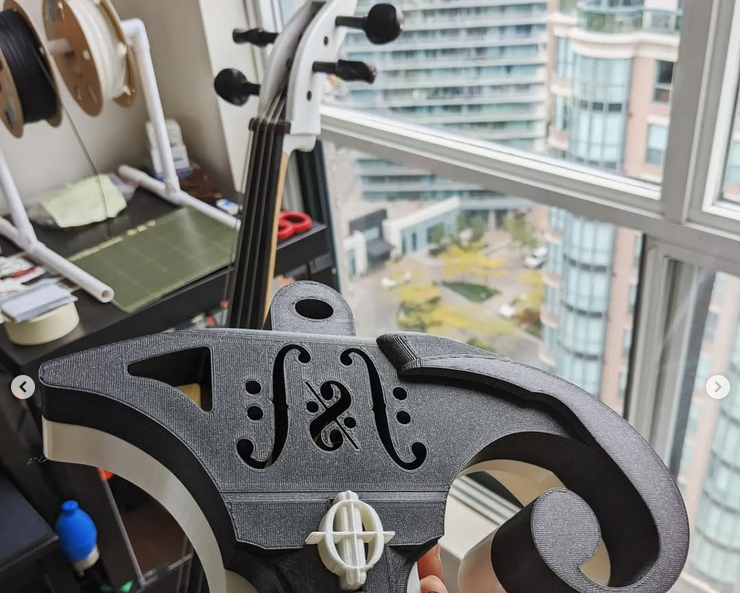How a Silent Cello Inspired an Optometrist to Start a 3D Printing Business

Dr. Vince Gao, a practicing optometrist, wasn’t trying to build a business. He just wanted to fix something.
His grandmother gifted him a silent cello designed for quiet practice. But it didn’t work.
For years, it sat unused, an awkward reminder of something that could’ve been great... if only it worked.
One day, he looked at the cello again and thought: Could I fix this myself?
That one question opened the door to a surprising journey.
The Spark — A Broken Cello
Vince didn’t have a background in engineering. No mechanical degree. No formal training in product design. But he was curious and he liked solving problems.
“The cello didn’t need a whole rebuild—just a small part,” he said. “That made me think, maybe I could design that one part.”
After extensive research, he used a friend's 3D printer to print the missing cello part. To his delight, the cello worked!
This led to another question: "What else can I build?"
Learning in the Margins
COVID slowed things down at his clinic. With longer gaps between patients, Vince had more time to think—and to tinker.
“I started watching YouTube tutorials on CAD and modeling,” he said. “I’d sketch a piece or tweak a design inbetween exams.”
He didn’t buy a printer right away. He created a few files and sent them to friends who owned printers. When the parts came back intact, he realized: "I can actually do this!"
The Fear of Not Knowing
Despite the progress, Vince was still haunted by a common fear: self-doubt.
“My biggest fear was not knowing what I didn’t know,” Vince said. "Not having any engineering or design background, I felt insecure about my knowledge".
That fear is enough to stop most people, but he kept going.
Ironically, the part he thought would be difficult—3D modeling—was easier than expected. Most of his designs used PLA plastic, which is forgiving and allows room for error.
But the hardest part?
“Assembling the printer itself,” he laughed. “You can buy one that’s pre-assembled, or get the DIY version for cheaper. Like Ikea but much harder. I chose the DIY version, and it took 18 hours to put it together.”
When asked if he did that because he loves building, he laughed again:
“No. It was just cheaper!”
From Hobby to Helping Others
As he started designing tools for his clinic—like holders, adapters, and organizers—others began to notice.
One day, a colleague asked, “Can I buy that?”
That moment was the spark.
Vince started an online store. He wasn’t trying to go viral or scale it big. He just wanted to share useful, niche tools with other optometrists.
“My favorite part is seeing the designs actually work,” he said. “I’m a results-oriented guy. The process is fun, but when something I made does exactly what it’s supposed to? That’s the best.”
The Power of Passion Project
His passion project looped back into his main optometry work in surprising ways.
He used it to fix broken parts in the clinic. He created new tools to help organize equipment and streamline his workflow. One simple tweak saved him seconds per patient, which added up quickly.
“Seeing my own creations improve my exam flow in meaningful ways gave me a profound sense of growth."
"Dream Big"
When asked if he had any advice for someone looking to start a creative project, Vince said:
“You have to dream big! At first, I thought I’d just make simple shapes. But once I started, I realized the complex stuff wasn’t actually that hard. Allow yourself to dream big.”
That mindset is key.
Too often, we aim for small goals because we think small is realistic.
Start small, sure—but don’t stay small out of fear. Your assumptions about what you can’t do are probably wrong.
If Vince had stuck to his original plan, he would’ve stopped at one cello part. Instead, he’s now designing tools, improving workflows, and helping others—all because he stayed curious and kept learning.
Don't Wait For a Perfect Time. Start Where You Are!
Vince didn’t wait to be 100% ready. He followed his curiosity. He learned in the margins. He found confidence by solving real problems.
This journey has redefined his career—not just as an optometrist, but also as a product designer. Just as important, he’s now helping other optometrists streamline their workflow through his creations.
So here’s the question I’ll leave you with:
What’s your passion project you've been meaning to start?
And if the familiar self-doubt creeps in, remember:
Like Vince said:
Dream big.
👉 Check out his online store here:
https://2020hindsightdesign.etsy.com/






Member discussion